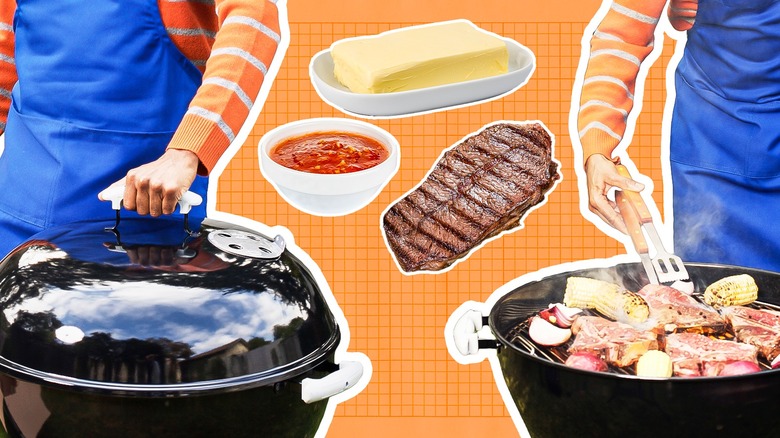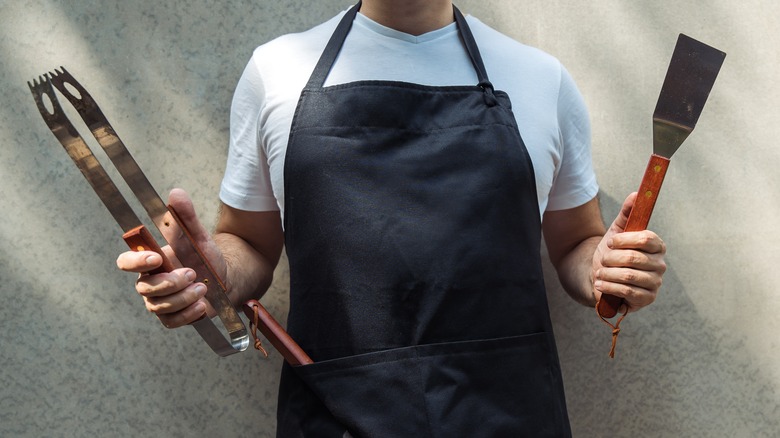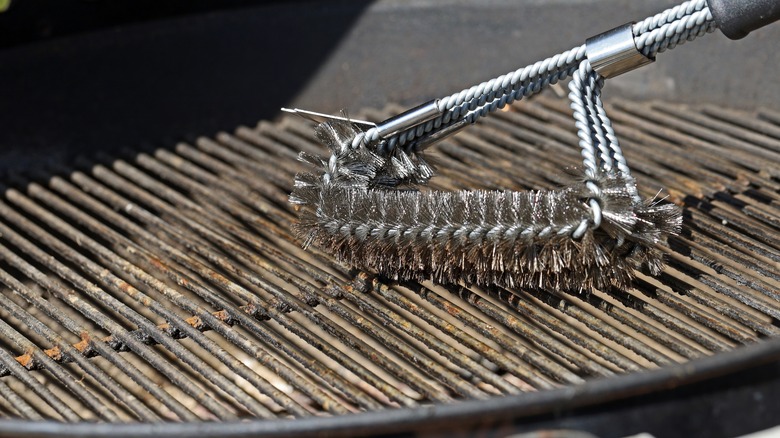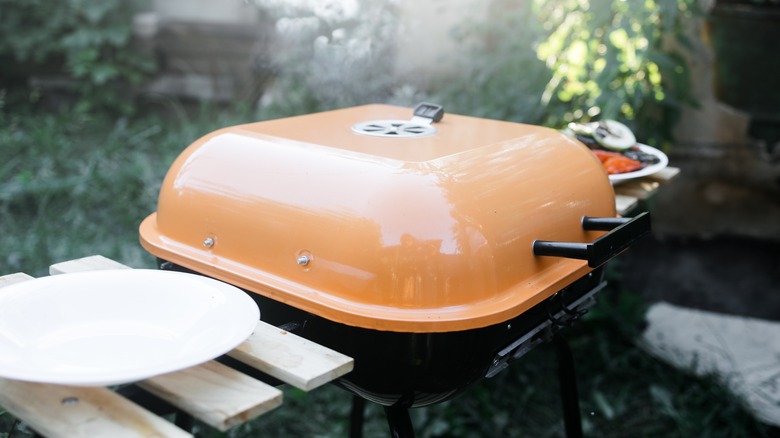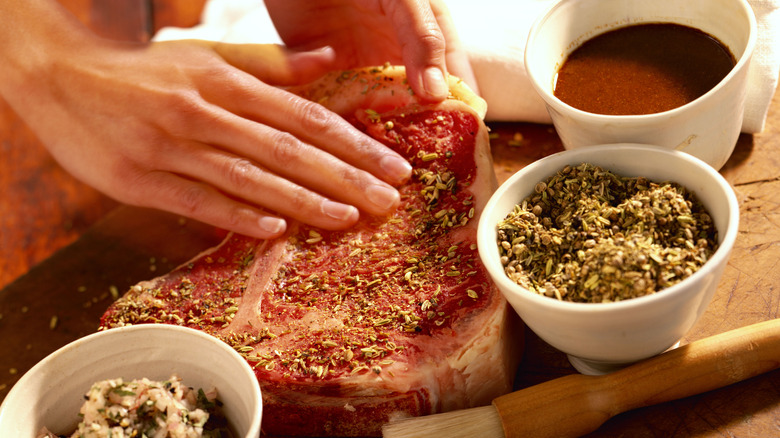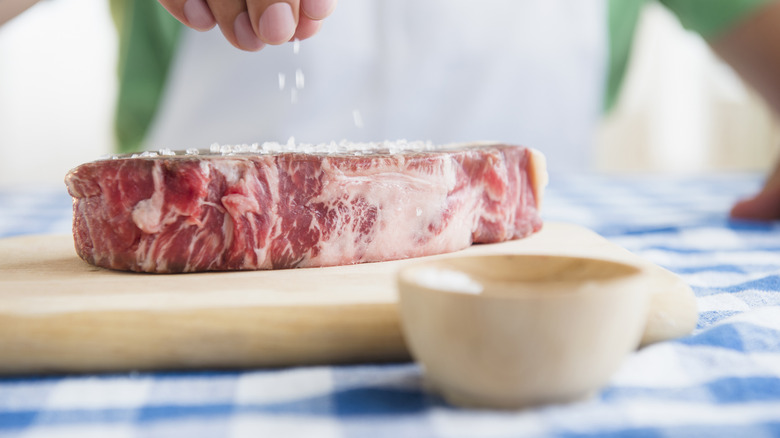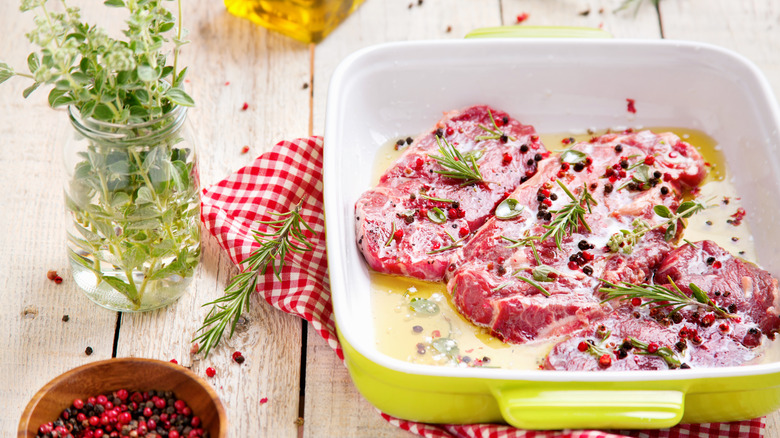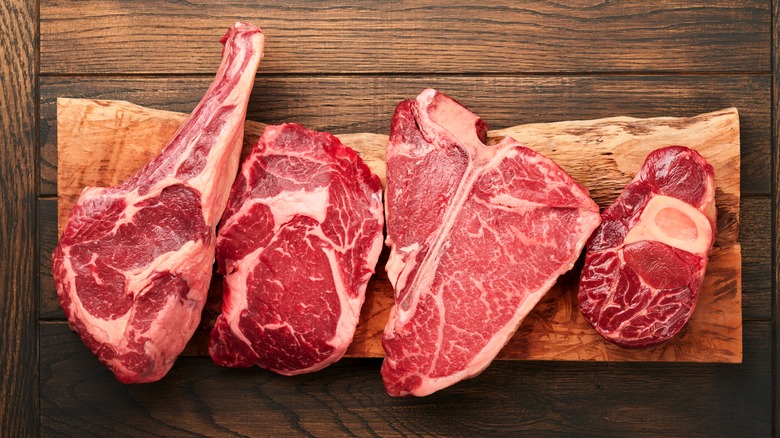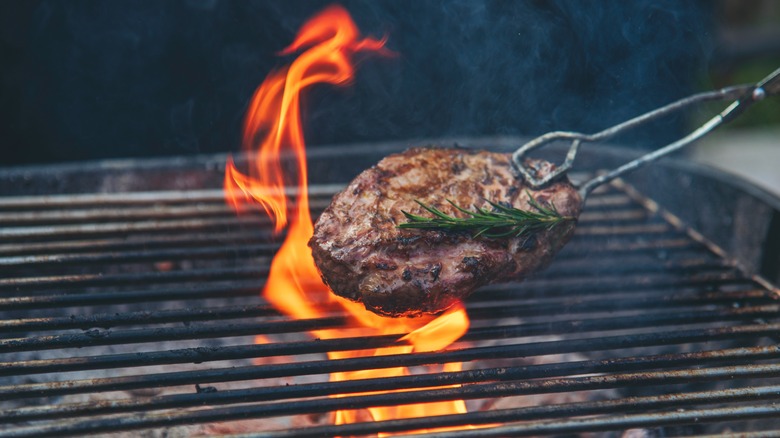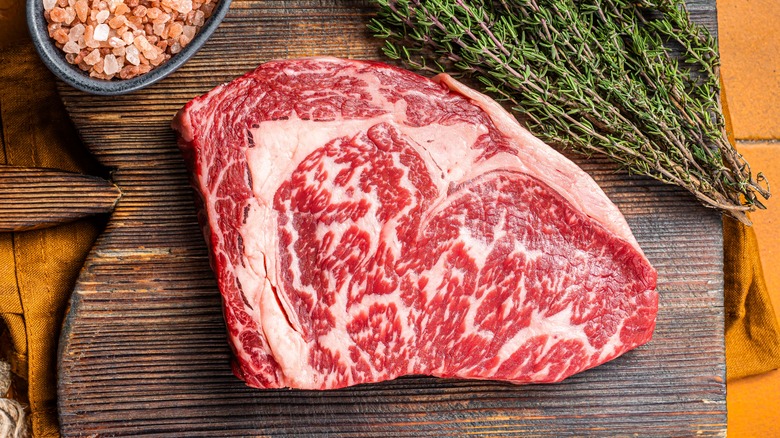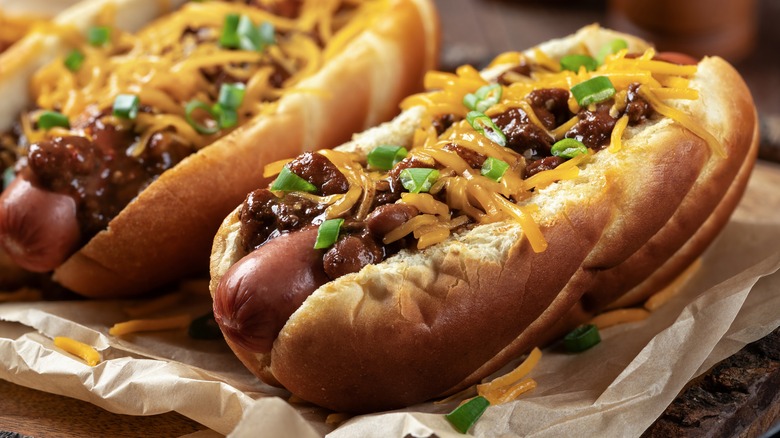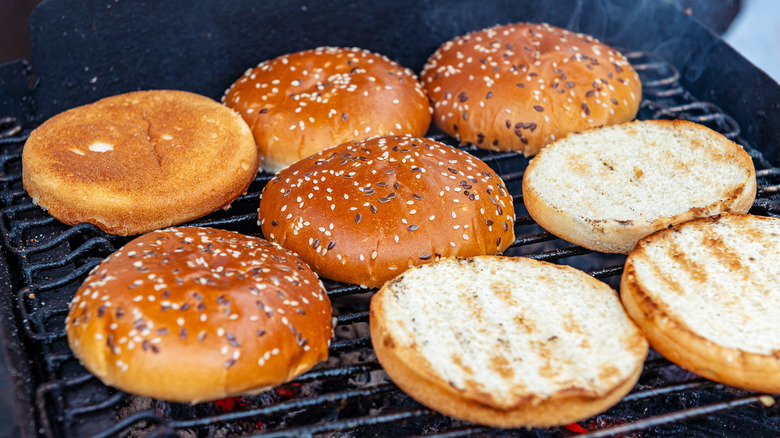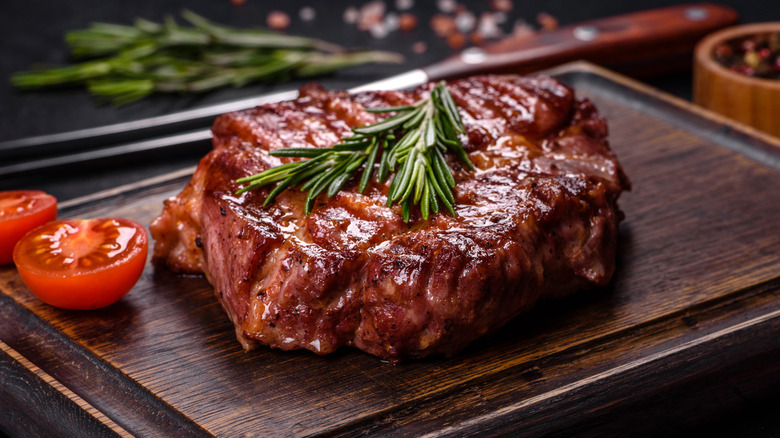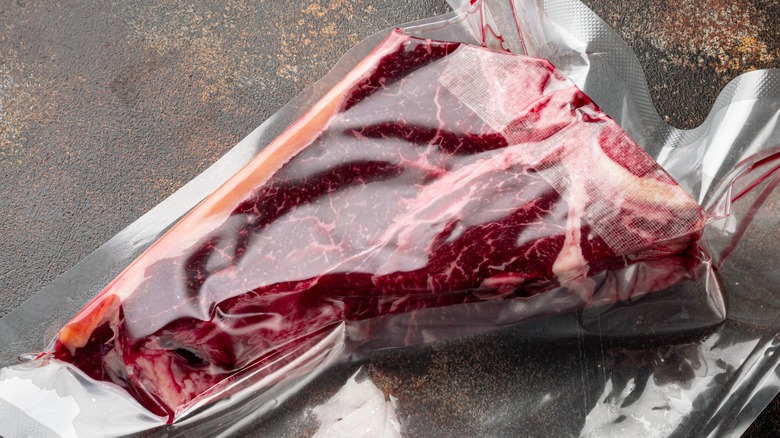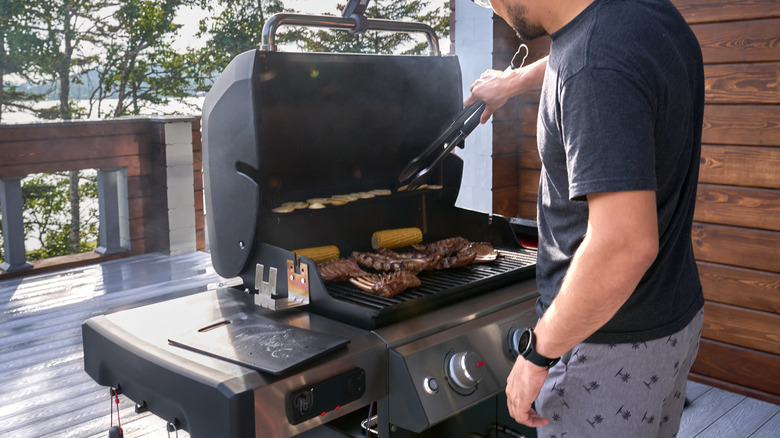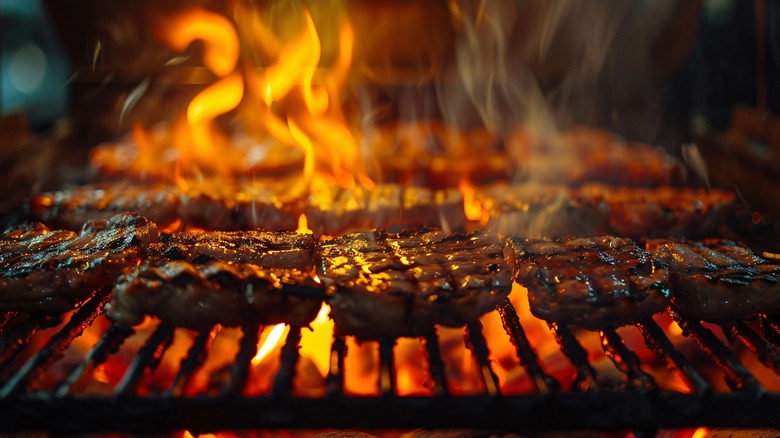Hacks That Will Change The Way You Grill Food Forever
Nothing beats a perfectly prepared grilled steak or smokey and charred BBQ chicken. But mastering the grill can be an art form that requires practice, patience, and more practice. Fortunately, we got the rundown on the best techniques and a few hidden secrets to fast-track your grilling education. These methods will make your steaks mouthwatering, your chicken swoon-worthy, and your grilled veggies delicious and tender. Some tips are specific to certain foods or cooking styles while others can be used across the spectrum of grilled dishes.
It's important to know that effective grilling and smoking starts before you even pull out your trusty tongs and tie up your apron. We gathered tips from chefs, spice connoisseurs, and expert pitmasters to help you level up your backyard barbecue game. From the preparation stage to grilling, serving, and cleaning, these hacks will have you grilling like a master in no time.
Check your tools
Giving your grill and other tools a once-over before your first planned use is the best way to prepare for your grilling session by making sure everything is in working order. The last thing you want is to find out that a part needs to be replaced on the day of.
"Be sure to get your grill or smoker out prior to your first cook and fire it up," advised John McLemore and John McLemore Jr., the father-son duo behind the bestselling cookbook, "Gather & Grill." "Ensure everything is working. Don't wait until your first cookout to realize you may need something for your grill."
Use this time to gather up your grilling tools as well, including tongs to grab and turn your meat, and foil to protect more delicate items. If you are a fan of plank grilling, consider stocking up on your favorite wood planks at the start of the season so that you are always ready to go.
Clean and season your grill
Clean your grill as needed to remove cooking residue and any built-up gunk, but don't overclean, John McLemore and John McLemore Jr. advised. A grill brush is a handy tool to scrub away leftover food but don't discount the heat from firing up the grill. "Clean off any major gunk, rust spots, or dirty areas," the pair said. "[Use] a vinegar/water mixture and coat with olive oil spray, then run your grill to burn off any bad residue. Don't be afraid to do [this] burn-off after a cook or at least every other cook."
Once the grill is clean, Yumna Jawad, founder, recipe developer, and cookbook author at Feel Good Foodie, seasons it with oil before using it. "Use tongs and a folded paper towel soaked in vegetable oil to lightly oil the grates to prevent food from sticking," she said. "Be cautious not to use too much oil as it can cause flare-ups."
Ultimately, the best steps to take for grill maintenance are the same ones you likely use on other tools in your kitchen. "Treat your grill like a cast iron skillet and it will last much longer," the McLemores said.
Keep the lid closed
Whether you are grilling or smoking, keeping the heat inside is key. "Don't be afraid of a little flame," John McLemore and John McLemore Jr. said. "Ensure your grill is clean and let it rip. Controlled flames are good, grease fires are bad." Yumna Jawad adds that this hack improves the flavor of your food as well. "Keeping the lid closed while grilling helps to trap heat and smoke, which adds flavor and helps to cook the food more evenly," she said. "Only open the lid when you need to flip or move your food."
When smoking meat, adjust your settings as needed to get the right amount of smoke. Heavy smoke isn't necessarily good smoke, according to the McLemores. "Thin blue while low and slow is the way to go," the pair said. Standard grills and designated smokers often allow you to fine-tune the smoke output, plus add wood chips for extra flavor and keep track of the meat's progress.
Try potent spices
Grilling allows you to be more heavy-handed when it comes to spices. Strong flavors can hold their own on the grill. Chef Lior Lev Sercarz, a spicemaster and owner of La Boîte, a global spice brand, recommends pimentón for a smokier flavor as well as cumin and cinnamon. You can also play with the texture of spices by adjusting the grind. "Use course spices or spice blends to season," Sercarz said. "Using more textured spices can create a beautiful, flavorful crust on fish or meat when grilling."
But Sercarz warns against using delicate spices since they often can't hold up when put on the grill. "Orange blossom flowers will burn from the intense heat on the grill," he said. "Examples of other spices to avoid include dried herbs (unless in a marinade), flowers (in general), and fennel pollen, which should be added after grilling." Knowing when to add certain ingredients can mean the difference between a burnt exterior crust and one that is just right.
Season before grilling
The longer you let the spices sit on your meat, fish, or veggies, the more intense the flavors are likely to be. Dry rubs and marinades work well because the spices can penetrate the food. "Use rubs or marinades to season your meat (and even veggies!) ahead of time," Chef Lior Lev Sercarz said. "This allows for the flavors of the marinade to penetrate your ingredients for a deeper seasoning."
This step is also important to actually preserve the flavor when the dish is cooking on the grill. According to Sercarz, adding spices ahead of time allows them to "hydrate," which prevents them from burning once they're put on the grill. "Marinate your meats and veggies up to three days ahead of cooking time," he advised.
Michael Saperstein is a James Beard "Rising Star" nominee and the co-owner of Sunshine Provisions, a premier high-end meat purveyor based in Florida. He recommends a simple salt and pepper blend on a steak. Or, try adding a little garlic powder to transform it into a burger rub. For a tasty chicken marinade, Saperstein likes salt, pepper, garlic powder, dried rosemary, and dried Greek oregano in a mixture of extra virgin olive oil and Dijon mustard.
Add fat to your spices
The best rubs, marinades, and sauces require the right application methods to be effective when grilling. You'll need some sort of oil or fat to make sure everything adheres to the food and stays on through the entire cooking process. Without it, dry spices end up in the grill's grates and don't add flavor. They can also create a mess and potentially burn, causing unwanted or uncontrolled smoke in your grill. "Use oil to adhere spices to your ingredients," says Chef Lior Lev Sercarz. "Otherwise, the spices will simply fall off."
You can also baste your food as it cooks but be careful with your timing if your mixture contains any sugar. "If you are adding sauce or extra marinade to the meat, don't add it too early as the sugars can burn," says Yumna Jawad. "If you are adding a sauce with sugar, wait until closer to the end of cooking."
Allow your meat come to room temperature
If you want to get evenly cooked food that sears well, don't throw your meat on the grill straight from the fridge. Letting it come to room temperature first will ensure it comes out just the way you intended. "Cold meat right out of the refrigerator will cause the grill to cool down immediately (and cook less effectively)," Chef Lior Lev Sercarz. "This can also lead to uneven cooking because the outside may be charred while the inside is undercooked. Start with a meat that is closer to room temperature for nice even cooking throughout."
Michael Saperstein says that putting cold meat on a hot grill will impact how the finished product looks and tastes. "When super cold meat hits a hot grill the steak will seize up and sometimes curl on the edges," he says. "By being at room temperature the steak will cook faster and much more tender."
Get the grill hot
One of the top tips to create a perfect char is to get your grill nice and hot, no matter what type of grill you use. "Whether using charcoal, gas, or electric, crank up the heat and give the grill time to get nice and hot for that perfect sear," says Chef Lior Lev Sercarz. "You can always turn the heat down during cooking or pull your meats off to the side but when you start at a lower temperature the grill will never be quite hot enough."
Let your grill preheat before putting anything on it, especially since adding meat, veggies, or other grillable food will change the temperature of the grill as well. Keeping it hot from the beginning will prevent any excessive cooling that might interfere with the flavor of the food. "Get that grill hot!" says Michael Saperstein. "It should be at least 500 degrees [F] before you put your meat on. This ensures a nice sear and will lock in the flavor."
Go for ingredient quality over quantity
Get the best quality steak and spices that work within your budget. If your meat is top-shelf, a simple salt and pepper seasoning is likely all that you need. You can look for meat quality labels, such as USDA Prime and USDA Choice, which indicate that the meat has excellent marbling and tenderness. Of course, these cuts are typically more expensive but you can save money by not needing any extra spices to boost the flavor.
Chef Lior Lev Sercarz notes that you don't need a lot of specialty ingredients for a delicious meal and to shop around to find the best options you can. "With something as simple as a well-seasoned steak, you want to ensure you're getting the best possible flavor typical of a top steakhouse," he says. "That requires high-quality ingredients. Don't bargain hunt or bulk buy cheaper items... quality is better than quantity."
Steam your buns
Grilling tips aren't limited to main dishes or meat. Prepping bread and buns on the grill is also a great way to get the best out of every ingredient so that they all work together on your plate. Throw your burger buns, rolls, and hot dog buns onto the grill to get the outside toasted and crispy. Just be careful not to burn the bread, since it likely doesn't need as much cooking time as meat and veggies.
John McLemore and John McLemore Jr. recommend getting your buns ready while you grill. "Cook your hot dogs (or meat of choice), take your buns out, place meat in hot dog bun, and then place each back into the plastic bag," they say. "Twist and seal to allow the buns to steam/soften before serving." This creates a perfect pillow soft bun for hot dogs or burgers. In fact, steamed hot dog buns are essential in many specialty and regional hot dog styles, including classic ballpark hot dogs and Chicago-style dogs.
Use butter for flavor
Adding flavor to your bread is also important when grilling. Grilling buns or bread with the butter side down is the perfect way to get extra flavor into your dish.
"Butter and toast your hamburger or white subs then toast on direct heat butter side down for the perfect toasted bun," recommend John McLemore and John McLemore Jr. "Place dinner rolls (or bread type of choice) on [the] warming rack and brush or spray with butter for 30 to 90 seconds to lightly warm your buns." The key here is not to cook the bread and buns but to let the exterior stay on the grill just long enough to develop a crispy, delicious crust.
You can also use oil to create a different flavor profile. Compound butter with herbs or cheese makes an excellent addition, both to grilling bread as well as on the top of a finished steak.
Let meat rest
A perfectly grilled steak loses all of its moisture and flavor if you cut into it too early. Let it rest for a few minutes after grilling to ensure that all of the juices make it back into the meat. "Let the steak have a chance to rest for 10-20 minutes (depending on size) before diving in," says Chef Lior Lev Sercarz. "The longer it takes to cook, the longer it should be allowed to rest so the juices can settle in and not be lost to the first cuts."
Michael Saperstein recommends a shorter rest time but likes to use a meat thermometer to check for doneness rather than cutting into the steak. "After the steak is cooked to the proper temperature (check with a digital probe thermometer) let the steak rest on the cutting board for two minutes before slicing," he says. By doing so, you can prevent juices immediately running out from the steak and creating more mess to clean up.
Reverse sear for a crowd
When prepping for a crowd, a reverse sear or sous vide is Michael Saperstein's go-to tip to get the inside of steaks cooked ahead of time. It cuts down on the time and attention that you need to devote to grilling and frees the chef up to mingle with guests and actually enjoy the day.
"There is nothing more stressful than having a full grill of steaks and trying to cook them all perfectly for a large party," he says. "I suggest using the reverse sear method or sous vide method in advance. This way you already have the steaks cooked to rare or medium rare and just have to char the outside quickly on a hot grill and they will be cooked perfectly with no stress." Reverse searing, which includes cooking the steak in the oven before searing, is a steakhouse secret that helps busy kitchens keep up the demand for a lot of steaks.
Set up two temperature zones
For the best control, use your grill's settings to designate two zones with different heat levels. This lets you move food from searing hot to low-temperature cooking for the finish.
Ashley Lonsdale, chef-in-residence at ButcherBox, calls dual-zone grilling one of her "key grilling techniques." She uses each one at different times in the grilling process. "This is a great way to control cooking speed, especially when grilling items that require different cooking times and heat levels," she says. "I bring one zone to a searing hot temperature and the other to a cooler temperature, which is perfect for cooking proteins slowly, like finishing a well-seared steak that's already got the right amount of char/crust."
Yumna Jawad also recommends getting familiar with the different types of heat and where you can find them on your grill. "Direct heat is heat directly over the fire, which is great for quick-cooking foods like burgers and vegetables. Indirect heat is to the side of the heat source, which is a great option for slower-cooking cuts like roasts," she says. "An important part of learning how to barbecue is knowing where to find specific heat on your grill."
Resist the urge to flip
When searing, your food needs time to develop the perfect exterior crust. This is due to the Maillard reaction, which happens when the meat is exposed to high heat and the chemical composition of the proteins change. What you get is a boost in flavor, crispy texture, and the sizzling sound that steak afficionados love to hear. However, even the best seasoning won't save your meat if you constantly move it around on the grill. Instead, put it on a piping-hot grill surface and let it cook for a few minutes. Flipping too early or too often will interfere with this process and cause the food to stick to the grill.
"Flipping once or twice is usually enough to ensure even cooking," says Yumna Jawad. "If you try to lift the meat before it is ready, it will stick to the grates. Let the meat develop a crust before you try to move it." This is also the perfect way to let the meat develop those desirable grill marks, which is one key spot where so much intense flavor will be.
